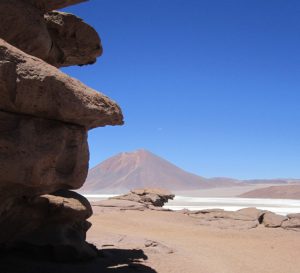Ignimbrite is a rock name. Ignimbrites form primarily from the collapse of eruption columns during explosive volcanism and are included in the general category of ground-hugging pyroclastic density currents (PDC). Our collective observations of PDCs over the last few centuries shows them forming primarily from explosive vulcanian and plinian eruptions that, on a human scale, have proven to be violent and destructive – witness the eruption of Mt. Vesuvius and burial of Pompeii in 79 AD (Giacomelli et al., 2003; PDF), Mt. Pelée and the destruction of Saint-Pierre in 1902 (Gueugneau et al, 2020; open access), and Pinatubo in 1991 (PDCs, airfall, and lahars).
And yet, as destructive as these recent eruptions were, they are minuscule compared to many ancient examples of thick, extensive ignimbrites that must have formed from supereruptions of cataclysmic proportions – some not so ancient; the Taupo supereruption was a mere 1800 years ago, the Oruanui (Taupo) event 26,500 years ago (Wilson et al, 2006). The shear power and violence of this type of eruption is difficult to comprehend.
The original definition of ignimbrite by P. Marshall (1932, 1935 paper reproduced here), based on a comparison of New Zealand examples with past events in the Valley of Ten Thousand Smokes, incorporated field-based criteria such as thickness, relationship to topography (do the deposits thicken in valleys?), consist primarily of juvenile pumice and ash, and the presence of welding. For many years welding was considered a prerequisite for ignimbrite status.
The decades following Marshall’s inspired investigations saw the term ignimbrite extended to all manner of pyroclastic flows – thick, thin, laterally extensive or of more local distribution, hot or cold including those that are not welded (e.g., the 26.5 thousand year old Oruanui ignimbrite, Taupo, Wilson et al., 2006; PDF). Giordano and Cas (2021) have attempted to rationalize this general terminological conflation with the following definition: an ignimbrite is “…the rock or deposit formed from pumice and ash- through to scoria and ash-rich pyroclastic density currents” regardless of thickness, areal extent, volume, composition, crystal content, relationship with topography, or temperature. This sounds like an anything-goes kind of definition, but Giordano and Cas also develop an ignimbrite classification scheme that distinguishes those formed from single vent eruptions (vulcanian and plinian, like Vesuvius and Pinatubo), from those of much greater magnitude and intensity that form during caldera collapse (issuing from multiple vents/fissures that ring the caldera); their diagram is reproduced below. This categorization is based on measurable quantities such as thickness, areal extent (flow run-out), volume, and aspect ratio. Dispersal area is controlled by the mass flow rate during an eruption and is a proxy for eruption intensity; likewise, flow volume is controlled by flow rate and the duration of the eruption and is a proxy for eruption magnitude.
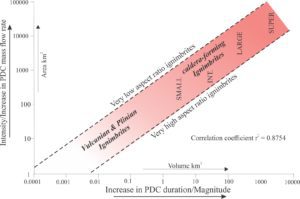

Classification of ignimbrites formed from single vent eruptions, and the spectrum of multiple vents or fissures associated with caldera collapse, of increasing eruption intensity and magnitude. Redrawn from Giordano and Cas, 2021.
[Aspect ratio is calculated as the average thickness versus the average lateral extent. The concept was introduced to volcanology by George Walker (1983) to distinguish the conditions that create ignimbrites (explosivity, eruption magnitude and intensity)]
[Eruption intensity refers to the rate at which the pyroclastic mass is ejected]
[Eruption magnitude refers to the total mass erupted – the scale of erupted volumes is also encapsulated in the Volcanic Explosivity Index, or VEI]
Common ignimbrite traits
The following list is based primarily on field and petrographic characteristics. In addition to the references cited, I have also drawn on the chapter on ignimbrites by Freundt et al., 2000 (Encyclopedia of Volcanology).
- Deposit thicknesses range from decimetres to 200 m and more. Thickness can be variable even within single flow units.
- Their distribution is largely determined by topography, thickening in topographic lows and thinning over ridges. Their geometry reflects the dominant control of gravity from collapsing eruption columns. Individual flows are capable of blanketing landscapes for 10s of 1000s km2.
- Calculation of the volume erupted needs to account for magma fragmentation, loss of volatiles, and the amount of fine ash dispersed far beyond the observed area of dispersal. It also needs to account for differences in pumice and glassy ash density compared with the equivalent dense, non-fragmented rock (i.e., solid lava). Therefore, erupted volumes are commonly quoted in terms of their dense-rock equivalent (DRE) – i.e., the equivalent volume of non-fragmented lava that in most cases would be rhyolite or dacite.
- Thick ignimbrites commonly appear massive, but on close inspection may reveal several stacked flow or cooling units separated by co-ignimbrite airfall tephra, thin pyroclastic surge deposits, or abrupt changes in grain size or crystal concentrations and composition.
- Grain size grading and stratification may develop in the upper and distal parts of flow units, reflecting waning turbulence in the former, and the transition to laminar fluid flow in the latter.
- Most ignimbrites have rhyolite through dacite compositions. They have an abundance of juvenile pumice, crystals, and pyroclasts of all sizes, although fine ash to coarse lapilli are more common. The term juvenile refers to derivation from the erupted magma.
- Within single flow units, crystal and pyroclast compositions may vary vertically and laterally. Some ignimbrites are crystal-phenocryst rich, others are crystal-poor. Such variations reflect the availability of materials in the magma, particularly as the magma chamber empties. Very large eruptions (supereruptions) may tap more than one magma chamber, and the magma composition in each may vary. This variation is reflected in the compositional zonation within and among closely spaced flow units, although mechanical winnowing of some crystal phases may also take place in the eruption column and ensuing PDC (see Wilson et al, 2021 for an excellent review of magma chamber evolution).
- Phenocrysts are commonly broken by the intensity of the eruption and by mechanical diminution during turbulent pyroclastic flow.
- Country rock derived from vent or fissure walls, or plucked from the substrate beneath a PDC may be added to the volcaniclastic mix.
- Welding is regarded as a syndepositional process. Welding, (also referred to as sintering) of pumice clasts and glass shards occurs when an ignimbrite is hot enough for glass to maintain a relatively fluid or ductile state during deposition. Experimental data on glass rheology indicates that temperatures greater than 800oC are required for this to take place (Lavallee et al. 2015; open access). Welding results in compression and stretching of pumice clasts, producing flame-like structures, or fiamme. Welding of finer ash produces agglutinated glass shards that, at a microscopic scale, appear to flow around phenocrysts and larger pyroclasts. Welding may be sufficiently pervasive to produce crude banding or layering (also called eutaxitic texture) that resembles flow-banding in felsic lava flows. Note that this kind of layering is not the same as that produced by laminar fluid flow in some PDCs.
- Eutaxitic textures, a term usually reserved for welded ignimbrites, refers to the layering produced by the flattening and collapse of pumice fragments, and the agglutination of glass shards during sintering.
- Columnar cooling joints are common in thick ignimbrites.
- Porous, non-welded ignimbrites are susceptible to fumarolic alteration of glass and phenocrysts during cooling.
Ignimbrites in outcrop
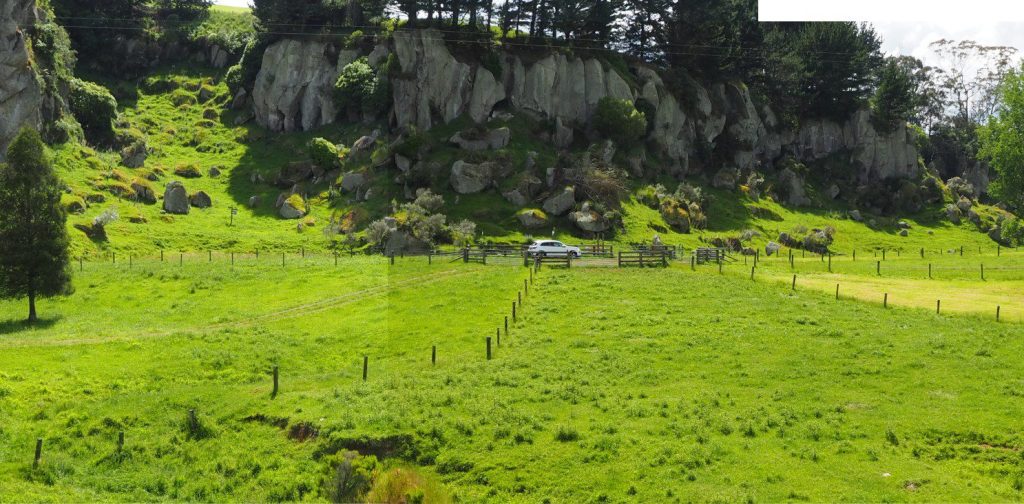

A panorama of the 1.21 Ma Ongatiti rhyolite-rhyodacite ignimbrite (Waikato, New Zealand), at least 11 m thick (base not exposed). At this locality (Castle Rock) there is no indication of extensive welding. At other localities, this ignimbrite is welded and contains several flow units ( Briggs et al., 1993) – see the thin section examples of welding in this ignimbrite. Elsewhere the ignimbrite thickens to 35 m and more. The eruption centre was the Mangakino Caldera (Taupo Volcanic Zone), about 20 km south of these cliffs. The dense-rock equivalent volume (DRE) is more than 500 km3.


Janine Krippner is intrigued by this pockmarked exposure of the Ongatiti Ignimbrite. The ‘holes’ are formed where soft pumice clasts are removed by weathering – giving us a good visual indication of their abundance. The largest clasts here have 40 mm long axes. Clast size sorting is extremely poor. Ignimbrite bluffs in this area are popular with rock climbers.


A relatively intact, non-sintered pumice clast with preserved vesicles (there is some iron oxide alteration), Ongatiti Ignimbrite (location as above).
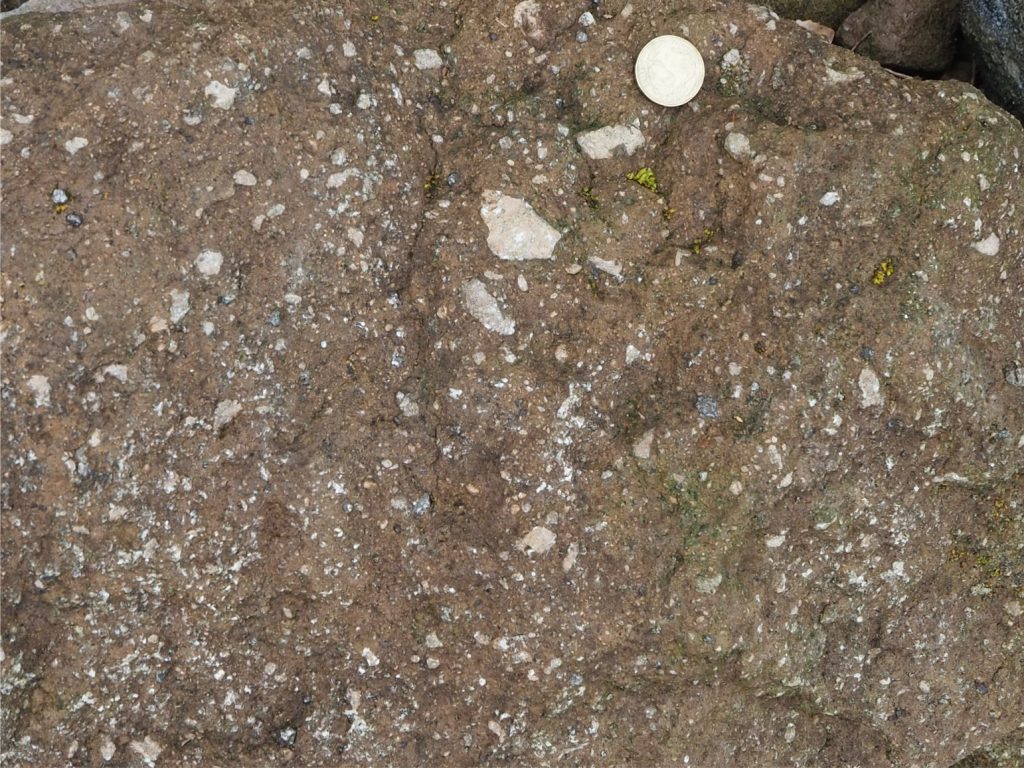

Non- to weakly welded, fine pumice and rhyolite lapilli dispersed in much finer grained glassy ash. Note the variation in shape and angularity, and extremely poor sorting. Part of the Okataina Caldera (about 320 ka) exposed along the shore and road cut of Lake Rotoma. Taupo Volcanic Zone, New Zealand. Coin is 23 mm diameter.
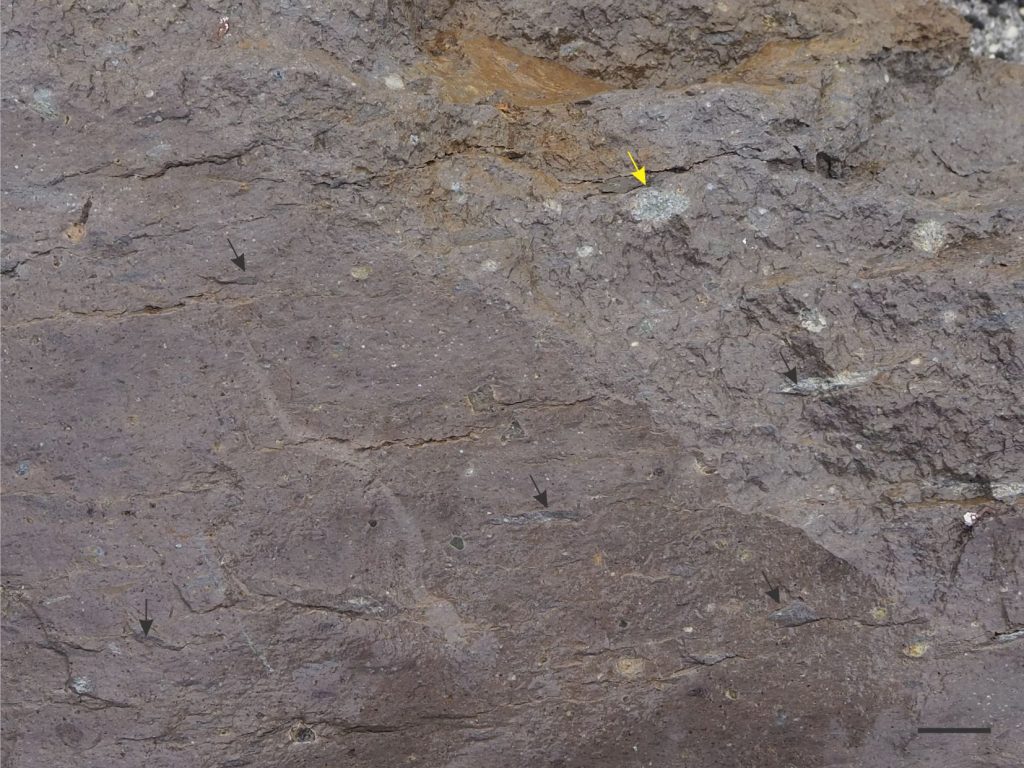

Welded ignimbrite exposed along the faulted shoreline margin of Lake Rotoma, part of the Okataina Volcanic Centre (about 320 ka). Most pumice fragments are stretched and flattened (arrows) but a few denser varieties are unchanged (yellow arrow). The ignimbrites are intercolated with flow banded rhyolites, spherulitic obsidian, and coarse breccias. Taupo Volcanic Zone, New Zealand. Bar scale 30 mm.
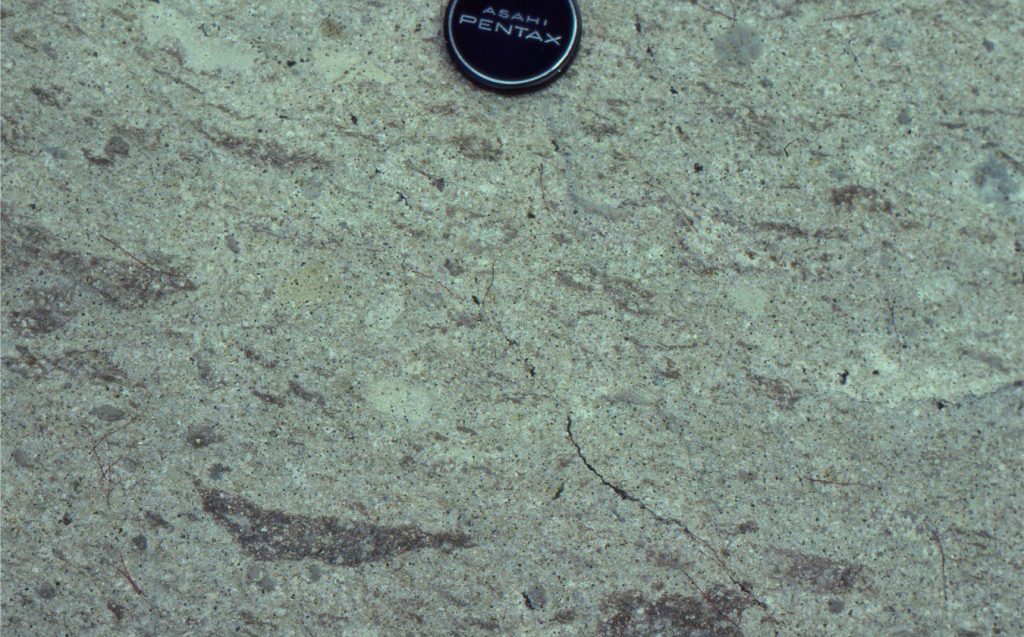

Intensely welded, flattened, and stretched pumice fragments forming typical fiamme. Welding is pervasive in this ignimbrite, part of the Late Pliocene Coroglen Subgroup, exposed north of Whiritoa, Coromandel Volcanic Zone.


The Mamaku Ignimbrite (240,000 yr) was one of the main eruptive products during the Late Pleistocene caldera collapse that formed Lake Rotorua. The upper, non-welded portion of the PDC was subjected to fumarolic discharge during cooling that resulted in pockets of cement hardened deposits. Subsequent erosion removed the soft, non-cemented ignimbrite, leaving upstanding remnants of the hardened rock preserved as steep-sided mounds capped by rocky spires and blocks. These landforms are called Tors, or Inselbergs. The top of the Mamaku Ignimbrite is littered with tors – shown in this Google Earth image. Taupo Volcanic Zone, New Zealand.


A tor at the top of the Mamaku Ignimbrite (west of Rotorua). The mound and spire are about 9m high. The general relief here also indicates the amount of denudation since ignimbrite emplacement. Taupo Volcanic Zone, New Zealand.
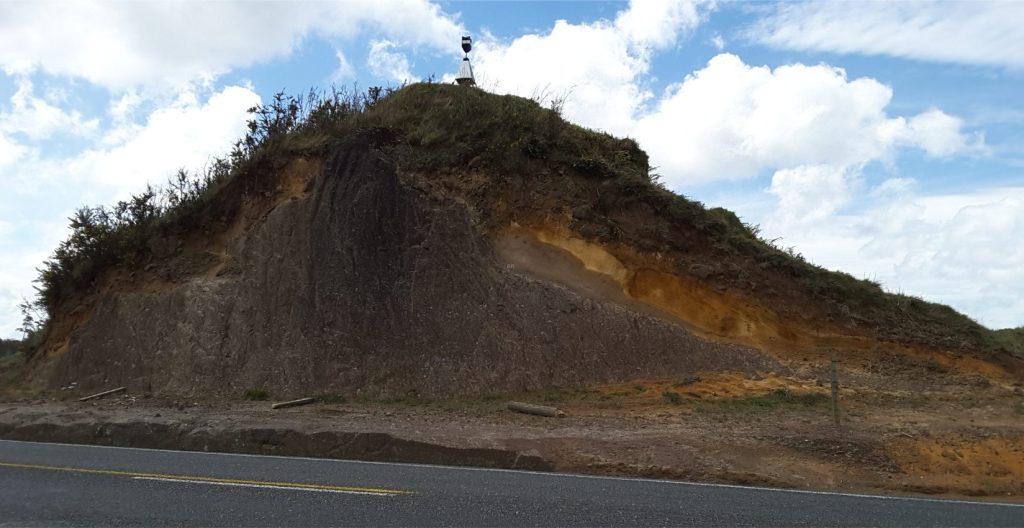

Road cut through a Mamaku Ignimbrite tor (Hwy 5, west of Rotorua). The eroded top of the Ignimbrite is draped by younger airfall tephra. See Google Earth image above for location. Taupo Volcanic Zone, New Zealand.
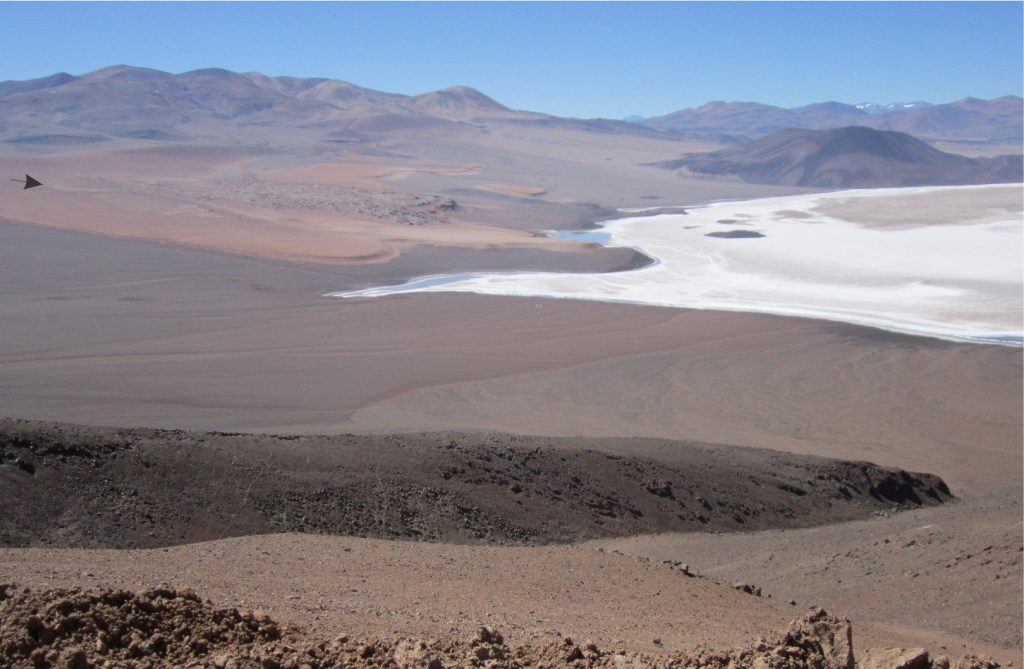

Eroded remnants of a Middle Miocene welded ignimbrite bordering Salar La Grande, Chilean Altiplano (orange hues, arrow top left). The high ground behind the ignimbrite is mostly composite andesitic and basaltic cones of similar age. The eruptive episodes were associated with Mid-Miocene caldera collapse. The ignimbrite is lapped by more recent, arid, alluvial fans, the alluvium derived from Mid Miocene basalts and andesites. The Salar is capped by thick (white) gypsum and halite crusts.
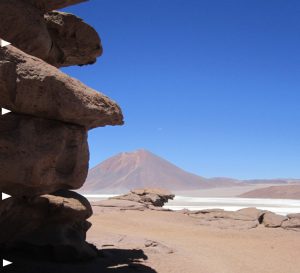

The ignimbrite (same unit as image above) is composite, consisting of overlapping flow units (white arrows) separated by subtle changes in pumice and crystal content, the contacts weathering out as apparent horizontal joints. About 5 m of section in this view. In the background, a nicely preserved Middle Miocene volcanic cone, plus a peekaboo view of Salar La Grande.
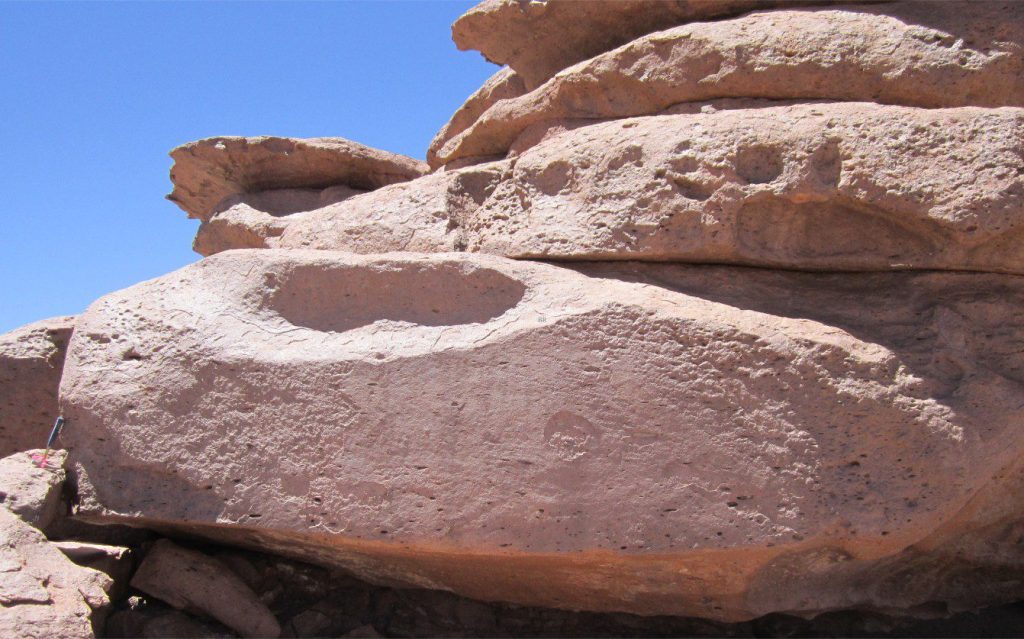

A closer look at the welded, flattened pumice, accentuated by weathering (same unit as image above). There is a crude alignment of the flattened clasts. Hammer lower left.
Ignimbrites in thin section
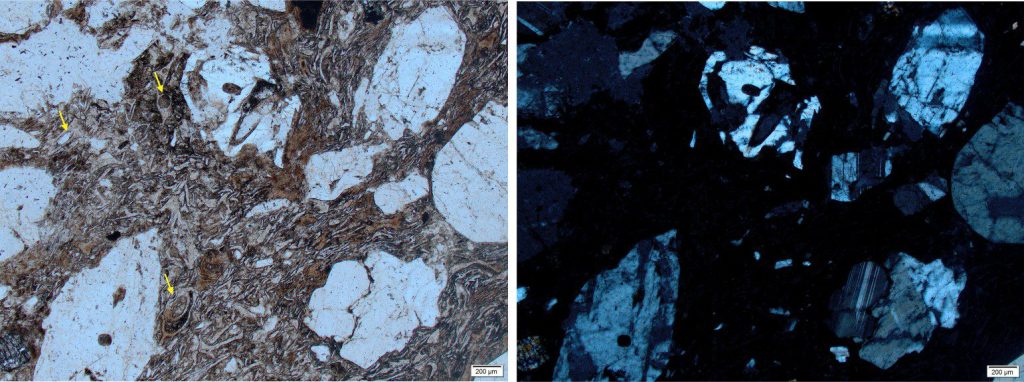

Welded 1.21 Ma Ongatiti Ignimbrite (located in a quarry at Hinuera). Left: Broken plagioclase phenocrysts are surrounded by flattened and stretched glass shards – compression has produced flow patterns around the crystals. The remnants of bubble-wall textures are seen in some shards (arrows). Plain polarized light. Right: The glass component is isotropic under crossed polars.


Welded Ongatiti Ignimbrite (same location as above). Prominent flow textures and flattening of glass shards occurred while the glass temperature was high enough to sustain ductile behaviour. The ragged phenocrysts are plagioclase, broken during eruption or during turbulent transport in the PDC. Plain polarized light.
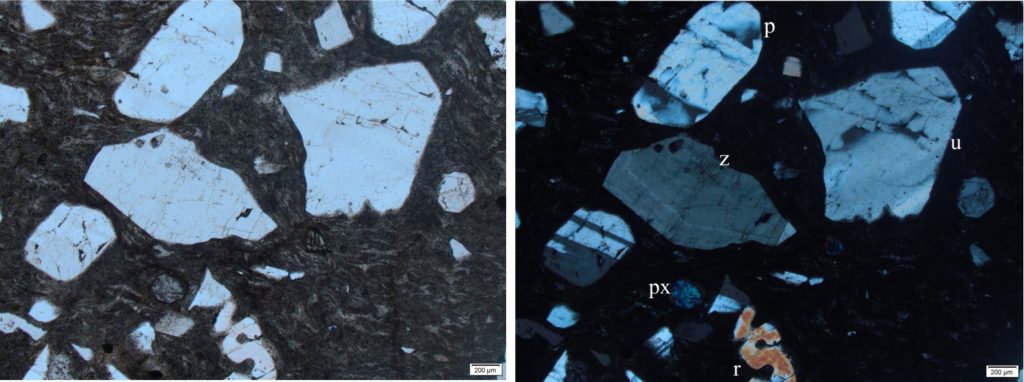

Intensely welded Matahina Ignimbrite (322 ka), part of the Okataina Volcanic centre. Taupo Volcanic Zone, New Zealand. The glass appears fuzzy (in PPL) because it has been altered by fumarolic activity during the post-depositional cooling phase. The phenocrysts are a mix of broken and complete crystals. Left: Plain polarized light. Right: Crossed polars. Note the preserved crystal faces on the plagioclase top left (p). Of the two broken plagioclase fragments, one is zoned (z), the other untwinned (it has good cleavage). There is a single, small pyroxene (px). The squiggly crystal at bottom centre may be a resorbed plagioclase (r): it has cleavage, but no twinning. Resorption occurs when there is disequilibrium between the magma melt and the solid crystal phase.
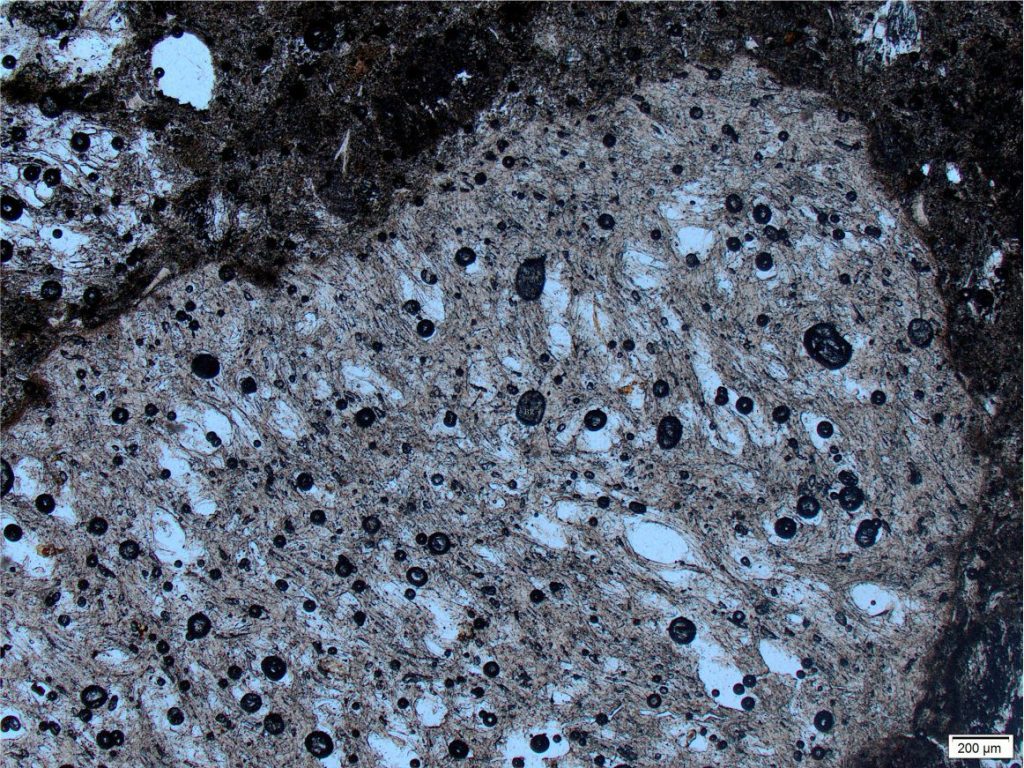

Pumice fragment showing good preservation of vesicles. Plain polarized light. Taupo Volcanic Zone, New Zealand.
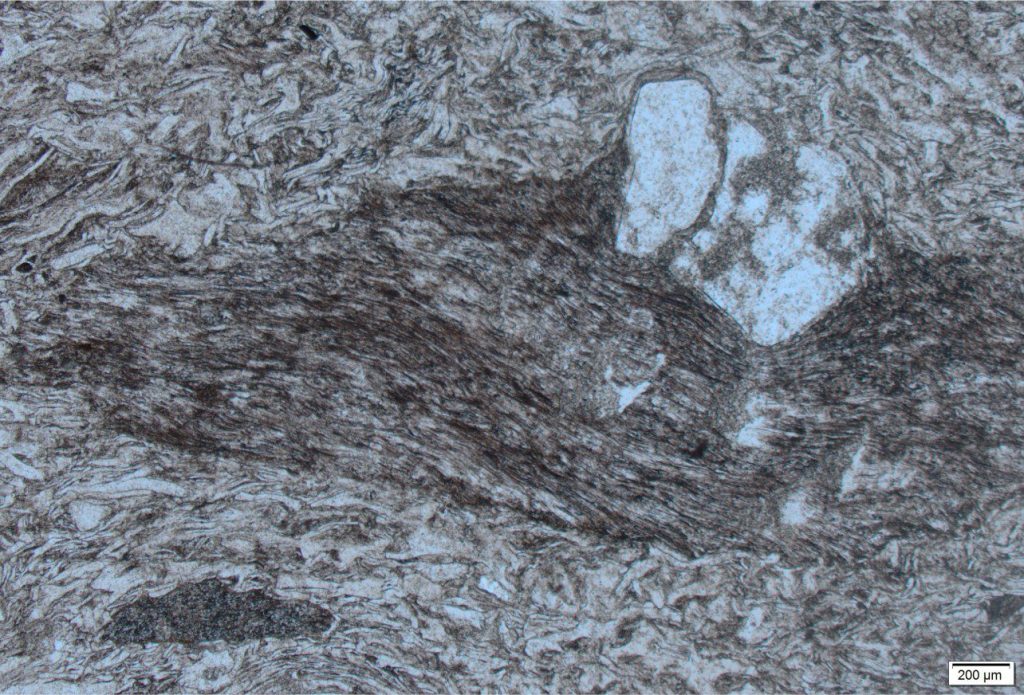

A seriously sintered, flattened pumice fragment, with collapsed vesicles. The fractured quartz phenocryst probably indented the pumice fragment during compression while the glass was still relatively fluid. Individual glass shards in the surrounding ash have also been welded together forming pronounced eutaxitic texture. Waiotapu Ignimbrite (710 ka). Taupo Volcanic Zone, New Zealand. Plain polarized light.
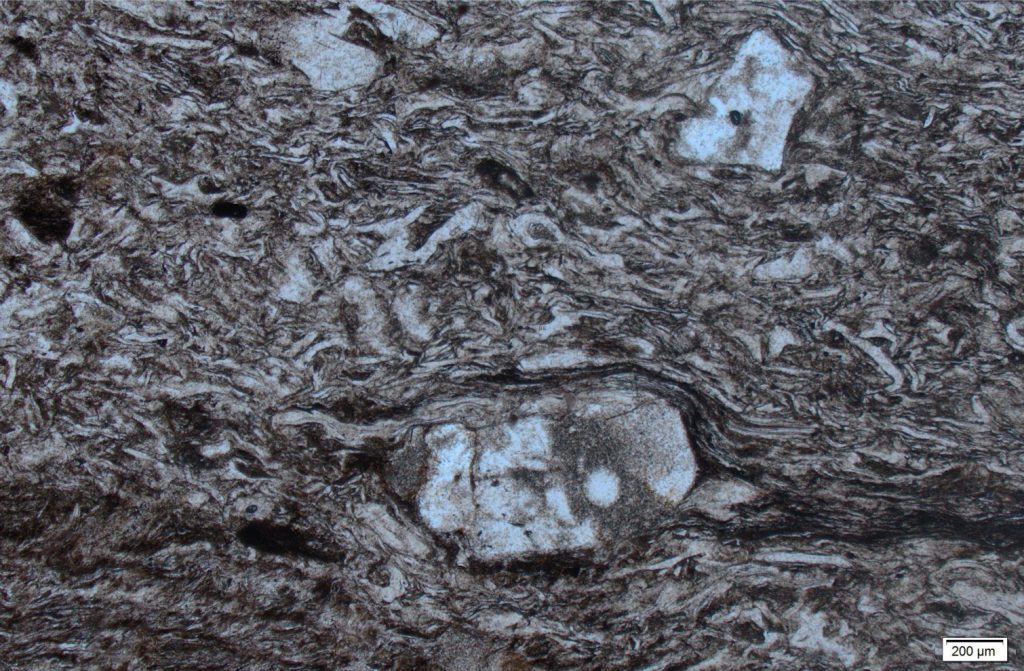

The rheology of volcanic glass during intense sintering is nicely illustrated here with flow and compression around a quartz phenocryst (lower centre). Most of the glass shards have been flattened. The glass in this and the previous image has been devitrified. Waiotapu Ignimbrite (710 ka). Taupo Volcanic Zone, New Zealand. Plain polarized light.
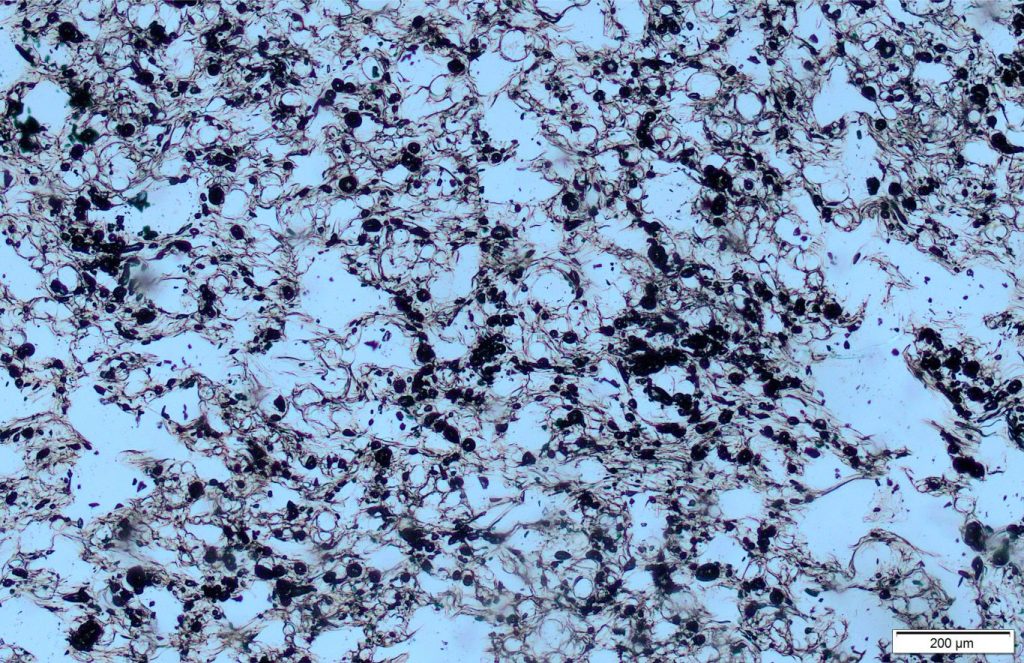

Fresh pumice from the Taupo supereruption, about 1800 years ago. No welding or compaction. The fragment is basically a collection of vesicles held together by a glass lacework. Plain polarized light. Taupo Volcanic Zone, New Zealand.
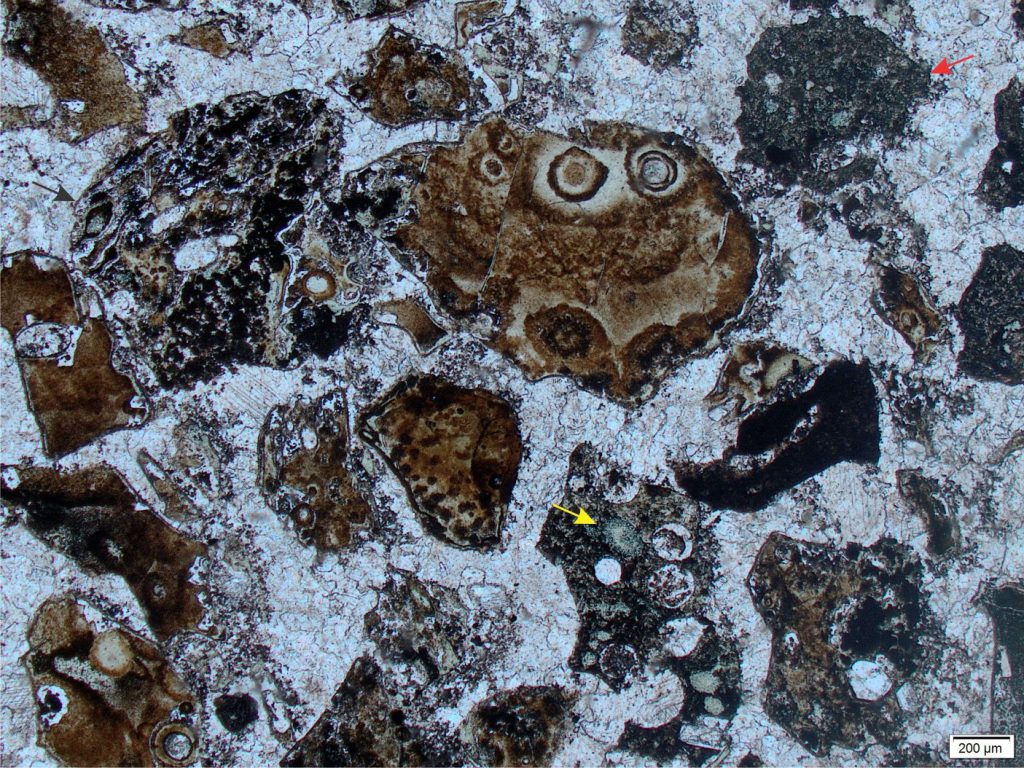

Pumice fragments from a thick PDC in the Paleoproterozoic Flaherty Fm. Belcher Islands. The associated volcanics (lava flows and pillow lavas) are basaltic and at least partly submarine. There is no indication of sintering. One clast has elongated vesicles and small, black, opaque hematite crystals (top left, arrow). Vesicles are filled with chlorite (yellow arrow) and calcite; the main cement is calcite. There are a few grains of altered basalt (red arrow). The original glass has been replaced by Fe oxides. Plain polarized light.
Acknowledgement
Many thanks to Kirsty Vincent, Earth Sciences, Waikato University for access to the petrographic microscope.
Related posts
Accretionary aggregates and accretionary lapilli
Ignimbrites in outcrop and thin section
Volcanics in outcrop: Pyroclastic density currents
Volcanics in outcrop: Secondary volcaniclastics
Volcanics in outcrop: Lava flows
Volcanics in outcrop: Pyroclastic fall deposits
Fluid flow: Froude and Reynolds numbers
Sediment transport: Bedload and suspension load
The hydraulics of sedimentation: Flow regime

